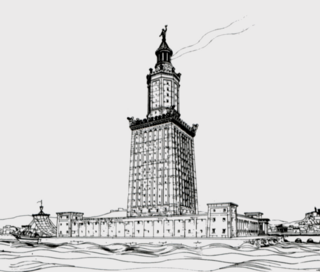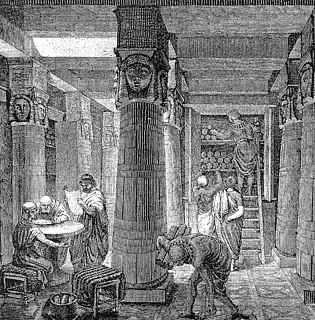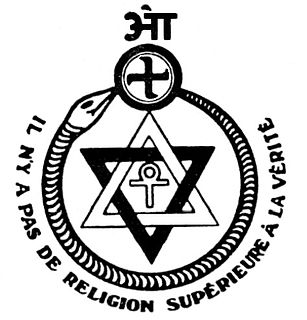
Euclid, sometimes called Euclid of Alexandria to distinguish him from Euclid of Megara, was a Greek mathematician, often referred to as the "founder of geometry" or the "father of geometry". He was active in Alexandria during the reign of Ptolemy I. His Elements is one of the most influential works in the history of mathematics, serving as the main textbook for teaching mathematics from the time of its publication until the late 19th or early 20th century. In the Elements, Euclid deduced the theorems of what is now called Euclidean geometry from a small set of axioms. Euclid also wrote works on perspective, conic sections, spherical geometry, number theory, and mathematical rigour.

The Lighthouse of Alexandria, sometimes called the Pharos of Alexandria, was a lighthouse built by the Ptolemaic Kingdom, during the reign of Ptolemy II Philadelphus, which has been estimated to be 100 metres (330 ft) in overall height. One of the Seven Wonders of the Ancient World, for many centuries it was one of the tallest man-made structures in the world.

The Great Library of Alexandria in Alexandria, Egypt, was one of the largest and most significant libraries of the ancient world. The Library was part of a larger research institution called the Mouseion, which was dedicated to the Muses, the nine goddesses of the arts. The idea of a universal library in Alexandria may have been proposed by Demetrius of Phalerum, an exiled Athenian statesman living in Alexandria, to Ptolemy I Soter, who may have established plans for the Library, but the Library itself was probably not built until the reign of his son Ptolemy II Philadelphus. The Library quickly acquired a large number of papyrus scrolls, due largely to the Ptolemaic kings' aggressive and well-funded policies for procuring texts. It is unknown precisely how many such scrolls were housed at any given time, but estimates range from 40,000 to 400,000 at its height.

Harpocrates was the god of silence, secrets and confidentiality in the Hellenistic religion developed in Ptolemaic Alexandria. Harpocrates was adapted by the Greeks from the Egyptian child god Horus, who represented the newborn sun, rising each day at dawn. Harpocrates's name was a Hellenization of the Egyptian Har-pa-khered or Heru-pa-khered, meaning "Horus the Child".

Ptolemy I Soter was a companion and historian of Alexander the Great of the Kingdom of Macedon in northern Greece who became ruler of Egypt, part of Alexander's former empire. Ptolemy was pharaoh of Ptolemaic Egypt from 305/304 to 282 BC. He was the founder of the Ptolemaic dynasty which ruled Egypt until the death of Cleopatra in 30 BC, turning the country into a Hellenistic kingdom and Alexandria into a center of Greek culture.

In ancient Egyptian religion, Apis or Hapis, alternatively spelled Hapi-ankh, was a sacred bull worshiped in the Memphis region, identified as the son of Hathor, a primary deity in the pantheon of Ancient Egypt. Initially, he was assigned a significant role in her worship, being sacrificed and reborn. Later, Apis also served as an intermediary between humans and other powerful deities.

In classical mythology, Hermanubis was a god who combined Hermes with Anubis. He is the son of Set and Nephthys.

The Hellenistic period covers the period of Mediterranean history between the death of Alexander the Great in 323 BCE and the emergence of the Roman Empire as signified by the Battle of Actium in 31 BCE and the subsequent conquest of Ptolemaic Egypt the following year. The Ancient Greek word Hellas is the original word for Greece, from which the word Hellenistic was derived.

Greco-Buddhism, or Graeco-Buddhism, is the cultural syncretism between Hellenistic culture and Buddhism, which developed between the 4th century BC and the 5th century AD in Bactria and the Indian subcontinent. It was a cultural consequence of a long chain of interactions begun by Greek forays into India from the time of Alexander the Great. The Macedonian satraps were then conquered by the Mauryan Empire, under the reign of Chandragupta Maurya. The Mauryan Emperor Ashoka would convert to Buddhism and spread the religious philosophy throughout his domain, as recorded in the Edicts of Ashoka. Following the collapse of the Mauryan Empire, Greco-Buddhism continued to flourish under the Greco-Bactrian Kingdom, Indo-Greek Kingdoms, and Kushan Empire. Buddhism was adopted in Central and Northeastern Asia from the 1st century AD, ultimately spreading to China, Korea, Japan, Siberia, and Vietnam.

A serapeum is a temple or other religious institution dedicated to the syncretic Greco-Egyptian deity Serapis, who combined aspects of Osiris and Apis in a humanized form that was accepted by the Ptolemaic Greeks of Alexandria. There were several such religious centers, each of which was a serapeion or, in its Latinized form, a serapeum.
Rhacotis was the name for a city on the northern coast of Egypt at the site of Alexandria. Classical sources from the Greco-Roman era, in Greek and in hieroglyphics, give Rhacotis as an older name for Alexandria before the arrival of Alexander the Great.

Serapis Bey, sometimes written as Serapis, is regarded in Theosophy as being one of the Masters of the Ancient Wisdom; and in the Ascended Master Teachings is considered to be an Ascended Master and member of the Great White Brotherhood. He is regarded as the Chohan of the Fourth Ray. C. W. Leadbeater wrote that Henry Steel Olcott was given occult training by Serapis Bey when his own master, Morya, was unavailable. A series of letters to Olcott, alleged to be from Serapis, encouraging Olcott to support Blavatsky in the founding of the Theosophical Society were published in the book Letters from the Masters of the Wisdom.

Hellenistic religion is the late form of Ancient Greek religion, covering any of the various systems of beliefs and practices of the people who lived under the influence of ancient Greek culture during the Hellenistic period and the Roman Empire. There was much continuity in Hellenistic religion: the Greek gods continued to be worshipped, and the same rites were practiced as before.

The Ptolemaic Kingdom was a Hellenistic kingdom based in ancient Egypt. It was ruled by the Ptolemaic dynasty, which started with Ptolemy I Soter's accession after the death of Alexander the Great in 323 BC and which ended with the death of Cleopatra and the Roman conquest in 30 BC.

Alexandria Bucephalous, was a city founded by Alexander the Great in memory of his beloved horse Bucephalus. Founded in May 326 BC, the town was located on the Hydaspes, east of the Indus River. Bucephalus had died after the Battle of the Hydaspes in 326 BC. The garrison was settled with Greek and Iranian veterans and Pauravas locals. It had large dockyards, suggesting it was intended as a center of commerce.
Archagathus was a Syracusan Greek prince and Ptolemaic official who lived around the late second half of the 4th century BC and first half of the 3rd century BC.

The Staff of Serapis is the sequel to The Son of Sobek and the second book in the Percy Jackson and the Olympians/The Kane Chronicles crossover series. It was released in the back of the paperback version of The Mark of Athena on April 8, 2014 and as a single e-book and single audio book on May 20, 2014. On April 5, 2016, it was released as the second of three short stories in a hardcover novel entitled Demigods and Magicians: Percy and Annabeth Meet the Kanes.


















